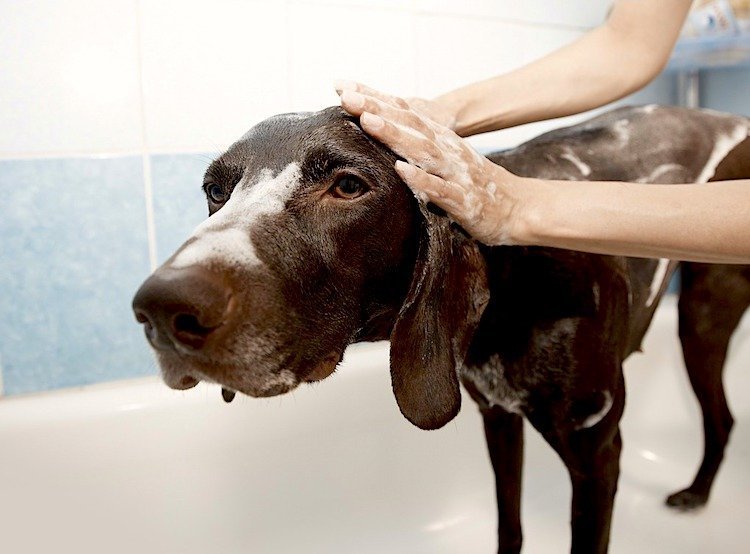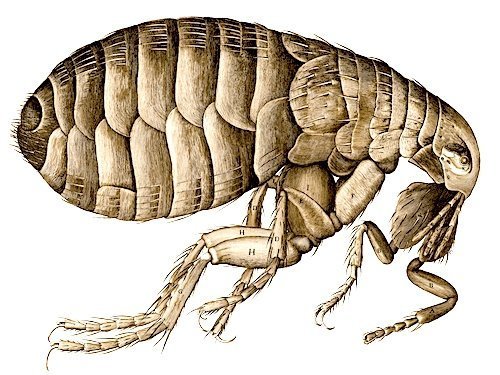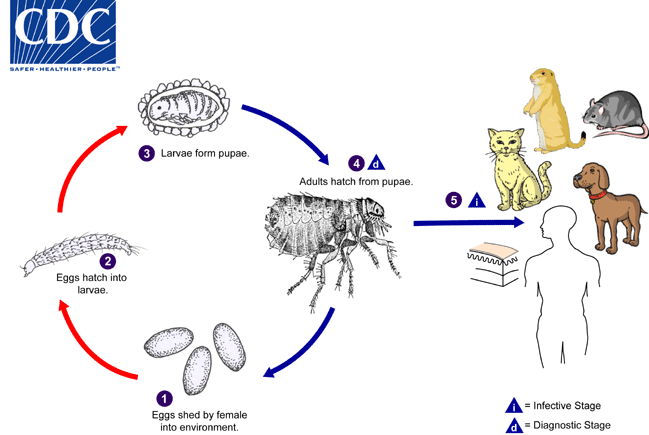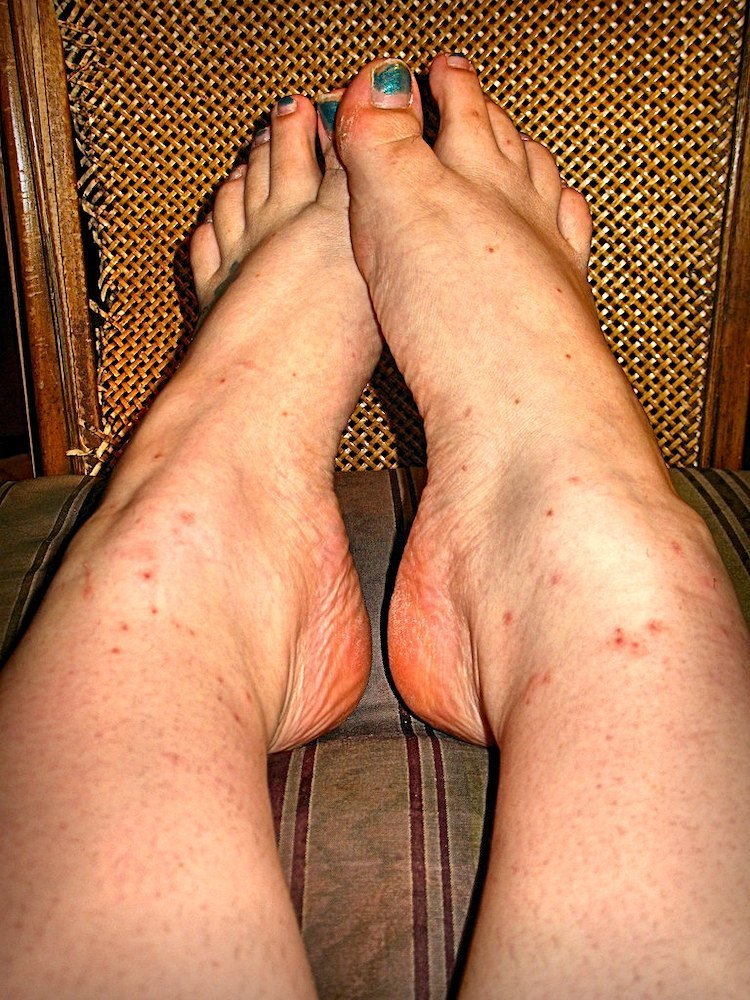
If you have a dog or cat, you’re probably wondering what’s the single best way to treat fleas.
The truth is, anyone can get a flea problem. No matter how advanced and safe flea products become, people can be lax about treating their animals, and their pets and households become infested.
If your pet is living in a flea-endemic area and you don’t use prevention, your pet probably will get some fleas.
If you let the infestation get out of hand, you will most likely have to use more flea products on your pets — and you’ll probably have to treat the environment. You may also have to treat itching and skin infections caused by the fleas.
As a veterinarian, I don’t like to see people forced to use products they don’t like, or having to spray their home with insecticides.
If you begin to check your pet early in the warm-weather season — or, in warm climates, all year round — then you may be able to stave off a big problem.
In this 4-part expert guide to the best way to treat fleas, we’ll cover:
- Do “natural” flea prevention methods (such as garlic) actually work?
- Everything you need to know about fleas, and why it matters
- Why your vet said she found fleas on your pet, yet you never see any
- How to treat fleas on your pet and in your home, including the 5 “golden rules” of killing fleas
- My final thoughts, biggest takeaways and hardest truths about flea control

Part 1: The Truth About Natural Flea Prevention
First of all, let’s go ahead and get this out of the way: There is no highly effective natural flea prevention if nature deals us a bad flea year.
Dr. Susan G. Wynn, DVM, DACVN, my hero when it comes to natural and alternative veterinary medicine, agrees.
She recommends flea combing your pet twice a day, every day for months, plus using a product like Fleabusters in your house if necessary. Dr. Wynn also suggests bathing your pet weekly.
“Natural” flea sprays need to be reapplied continuously, in her opinion, which makes them fairly useless.
Remember that “natural” does not equal “safe”:
- Essential oils can be toxic to your pet. Some create skin eruptions, or they can be toxic when ingested with normal grooming.
- I find the odors from many of the “natural” products so offensive that they may upset your pet as well.
- All this and they don’t work well.
If you roll with the alternative and natural folks, please be vigilant early about fleas and you may be able to avoid more conventional flea treatments.

Does Garlic Prevent Fleas?
No, garlic does not prevent fleas. Actually, garlic can make your pet sick — but the fleas living on your pet will be just fine.
Healthy pets are not immune to fleas. Although it is true that pets in poor health are more prone to parasites, I’ve seen thousands of healthy dogs and cats, fed a superb diet, crawling with fleas.
Fleas are not choosy: They bite the healthy, the young, the old and you.
Fleas can happen to the best of us, the worst of us, the smartest of us, the most informed and uninformed of us. If you are finding fleas, you need a plan to get rid of them.
Was YOUR Pet Food Recalled?
Check Now: Blue Buffalo • Science Diet • Purina • Wellness • 4health • Canine Carry Outs • Friskies • Taste of the Wild • See 200+ more brands…

Before we attempt to get at the best way to treat fleas, let’s first run through some important background information on these little pests …
Part 2: Everything You Need to Know About Fleas
Here are 3 essential facts about fleas:
- There is no such thing as a “small” flea problem.
- Early intervention will ensure your big flea problem does not get bigger.
- Fleas can come from your yard, feral and wild animals, or the dog park. People can bring in “hitchhiker” fleas to indoor pets.

The Flea Life Cycle — And Why It Matters to You
OK, ever wondered why fleas are so hard to get rid of?
Fleas are tough and can survive a trip through a washing machine — and they have a life cycle geared to survival.
These 4 flea life cycle facts show just how successful fleas are at breeding and why they’re a pest to get rid of:
1. The adult fleas feed on the pet, but then hop off in the home.
This means bathing your dog to get rid of fleas removes just a tiny proportion of the problem.
2. Only 5% of the flea population is made up of adults. The remaining 95% are eggs, larvae and pupae.
This means that killing the adult flea is only the tip of the proverbial iceberg. If you have a serious infestation, you must tackle the other 95% by treating your home.
3. From egg to adult can take just 12–22 days under ideal conditions.
There are plenty more fleas following right behind the one you just squished.
4. A single adult flea can lay 50 eggs a day, or 2,000 in her lifetime.
If each egg hatches out and lays another 2,000 eggs … itchy, itchy!
The bottom line: If the flea infestation is anything other than in the earliest stages, then unfortunately you will need to treat the environment. Those flea eggs are nestled down in the soft furnishings and carpet.
If you regularly find fleas on your pet, even after regular combing, then treating your home with an effective product is almost inescapable.

Flea Myths
- “Only the dog goes out, so I’m not treating my indoor cats.” Bad idea! Cats are fabulous reservoirs for fleas. If there is a flea problem in the house or on the dog, all pets should be treated, even if you don’t see concrete evidence of fleas on all the pets.
- “I never had a flea problem before this year, so this must not be so bad.” Wrong! For whatever reason, a flea problem can just happen. Treat quickly and aggressively, even if you believe you have never had fleas before.
- “That stuff the vet sold me doesn’t work.” Harsh truth: The flea product recommended by your veterinarian is probably an effective product, whether you bought it online, at your vet’s office or over the counter.
No flea product is 100% effective, particularly if you have used it only for 1 month or so.
For the best way to treat fleas, you will need to treat all of your pets for a longer time. And, again, you may also have to treat the environment.

Your Vet Found Fleas — But You Didn’t See Any
It’s not all that easy to find fleas. But in the past week, I’ve found fleas on 10 animals. None of the pets’ humans knew they had a flea problem.
Here are my suggestions:
- Buy a flea comb. They are worth their weight in flea gold. Get a plastic one for 99 cents, or invest in a flea comb with a wooden handle for a few bucks. And use it!
- Comb through your dog or cat. See if you find a flea or flea dirt.
- What is flea dirt? It’s flea feces. Yes — flea poop. If you comb your dog or cat and find some black specks, collect them and dot them onto a wet paper towel. If the little peppery specks leave a reddish to orange/brown color on the paper towel, then this is flea excrement. The red spot is digested blood in the flea poop. If the black speck leaves nothing but a little gray or black spot, it’s just driveway dirt.
Flea dirt can be a conversation stopper at a dinner party. People ask vets the strangest questions over dinner …
Veterinary dermatologists believe that at least 50% of scratching dogs and cats are flea-allergic. This means that if your pet has atopic (allergic) disease, flea control should be in place for most or all of the year.
Flea allergy adds to or causes the greatest degree of scratching, biting, hot spots, and fur pulling in dogs and cats.

Part 3: How to Treat Fleas
The best way to treat fleas is to devise a treatment plan that you feel comfortable with.
Please don’t waste your money on ineffective products with false claims. Talk with your veterinarian. Buy products wherever you like — but get intelligent advice first.
If your flea problem is truly out of control and you have an infestation, realize that you may need to treat your home as well.
The 5 Golden Rules of Killing Fleas
If your pet is suffering from a flea infestation, it’s time to get serious about flea control. Apply these 5 golden rules, and the fleas will be gone:
1. Use an effective product.
Only those products that are “licensed” to kill fleas are guaranteed to do just this and have the clinical trials to prove it. (See the “Flea Treatment Options” section below for some charts listing specific flea products.)
Be aware that not all spot-on products are the same. Yes, the method of delivery is the same, but the ingredients can be very different.
2. Apply the product correctly.
Many spot-on drops need to dry in before the pet is stroked. Be sure to follow the instructions about application closely.
3. Apply at the stated interval.
How often do you apply those flea drops? Chances are, it’s not often enough. Check the packaging and follow the guidelines.
4. Apply to all the pets in the home.
If you skip one pet, that pet will act as a safe haven for fleas looking for refuge. There’s no way round it — proper control means treating all the pets in the home.
5. Treat the environment.
Vacuum regularly (to suck up flea eggs), wash pet bedding and, if necessary, use an insecticidal product on the soft furnishings.
A Special Note About Flea Allergies
Flea bites are itchy. But some pets suffer out of proportion to others. These unfortunate fur-friends suffer from flea allergic dermatitis.
A typical cat with flea allergic dermatitis has small scabs scattered over their skin, which gives them a gritty feel when stroked. These guys don’t need to be riddled with fleas; a single bite can do it.
This is because it’s the flea saliva that causes the allergic reaction. Think of it like someone with a peanut allergy — a single nut is enough to cause a serious problem.
If your cat has flea allergic dermatitis, then treat them all year round and treat any pets they live with. Remember, one bite is all it takes to trigger that itchy reaction.
Flea Medications
Check out the video below by Dr. Wayne Rosenkrantz, DVM, DACVD.
Dr. Rosenkrantz is a great dermatologist who does not want to use more chemicals than necessary.
He’s a big fan of the oral flea treatments, like Comfortis (available from your vet). There’s a lot of evidence-based research on the safety of the new oral and topical flea medications.
As he states, these products are much safer than the sprays and dips we had to use in the past:

I don’t use the oral medications much in my practice because they do not prevent ticks. Dr. Rosenkrantz practices in California, where ticks are not as endemic as in the Northeast. It used to be these oral products didn’t kill ticks, but now there are options that do. Check with your vet about the best options for your dog and cat.
Finding the best product that addresses fleas, ticks, heartworm and intestinal parasites is the key.
I realize these medications are expensive. That’s why your vet should be able to steer you in the direction that’s best suited to your pet and controlling the parasites in your geographical area.
Flea Treatment Options
There’s a huge and frankly baffling choice of flea products these days.
To find your ideal product, first think through what you need that product to do. Then chat to your vet who can match these needs with an available option.
Your ideal product for treating fleas on your pet? Think through these questions:
- What do you want the product to do? Do you just want the product to kill fleas on your indoor cat, or does your dog need protection from ticks and/or heartworm?
- What formula works best for you? Pills, collar, spot-on or spray? Each has pros and cons. Think about factors such as how easy the cat is to pill, how thick the dog’s coat is, and whether you have children who will want to snuggle with the pet straight after a treatment.
- How important is a long-acting product? Or will you remember to reapply a short-acting preparation regularly?
- Do you have lots of pets of different sizes? Buying the right size pipette for each pet can be pricy, whereas a spray can treat them all.
Take your wish list to the vet, who can advise you from there. However, here are just some of the options available to choose from:
Tablets/Chews:
| Product | Comment |
|---|---|
| PetArmor Fastcaps | Same active ingredient as Capstar (see below), but cheaper. Kills adult fleas but works for only 1 day. Ideal to stop a new pet from bringing fleas into the home. |
| Capstar | Kills adult fleas within 20 minutes. However, it acts for only 24 hours and then the pet is no longer protected. |
| NexGard Spectra | A tasty once-monthly chew that works against fleas, ticks, heartworm and some common worms. Available from vet clinics. |
| Bravecto | One oral dose of Bravecto for dogs can kills fleas and ticks for 2–3 months. Available from vet clinics. |
Flea Collars:
| Product | Comment |
|---|---|
| Seresto | Clinically proven to kills fleas and ticks for 7–8 months. |
Spot-On:
| Product | Comment |
|---|---|
| Frontline Plus | Kills fleas, larvae, eggs and ticks. Once-monthly application. |
| Sentry | Once-monthly application. Kills flea adults and larvae, as well as ticks and lice. The same ingredients as Frontline Plus but cheaper. |
| Advantix II | Repels fleas, ticks and mosquitoes. Monthly application (but more frequently against mosquitoes). |
| Advantage II | Kills adult fleas and sterilizes the eggs they lay (so the eggs can’t hatch). |
| PetArmor | Kills adult fleas, ticks and lice. |
Flea Combs:
| Product | Comment |
|---|---|
| Flea Comb | Helps remove live fleas from the coat. |

Flea Comb: Get One Now and Use It
As Dr. Wynn recommends, flea combing your animals frequently during flea season will keep you aware of the severity of the problem.
Look for those little black specks on your cat or dog’s abdomen or trapped in the flea comb. That’s probably not dirt from the driveway. That’s flea dirt (again, that’s just a nice expression for flea poop).
I love flea combs. Get one with the nice wooden, brown handle. Or get a plastic one that costs 50 cents. And use it!
Many pets like it. They’re great for grooming shorthair cats.

Part 4: Final Thoughts on Flea Control
You are certainly entitled to your own ideas on flea control:
- Natural products versus conventional
- Or over-the-counter flea products versus veterinary products
But if you’re finding fleas at this time of year, or if you’ve been seeing fleas for several months, your prevention program has failed. Bottom line: Your animal is suffering.
Letting your pet get so infested with fleas that they’re running across her face or your white socks is cruel.
Oh, you don’t know about the white socks test? Clients like to brag to me that when they wear their white socks and they can see the fleas on the socks, it’s time to treat. No. It might be time to move!
This is an out-of-control flea infestation. (Believe me, landlords know about fleas. The students move out. They leave their garbage, old furniture and 100,000 fleas.)
Many people still don’t seem to understand that having fleas biting your body constantly is horrible. Well, how about if I go outside, pick up some poison ivy, and rub it all over your arms and legs? Or just set you on a porch at dusk with 200 mosquitoes!
References
- DPDx. “Fleas: General Flea Life Cycle.” Centers for Disease Control and Prevention. Dec. 8, 2017. https://www.cdc.gov/dpdx/fleas/index.html.
- Hunter, Tammy, DVM, and Ernest Ward, DVM. “Flea Allergy Dermatitis in Cats.” VCA Hospitals. 2018. https://vcahospitals.com/know-your-pet/allergy-flea-allergy-in-cats.
- “Seresto Collar.” National Office of Animal Health. https://www.noahcompendium.co.uk/?id=-446720.
- “NexGard Spectra Chewable Tablets for Dogs.” National Office of Animal Health. https://www.noahcompendium.co.uk/?id=-453829.
- “Bravecto Chewable Tablets for Dogs.” National Office of Animal Health. https://www.noahcompendium.co.uk/?id=-454352.
 This pet health content was written by a veterinarian, Dr. Debora Lichtenberg, VMD, with contributions from another veterinarian, Dr. Pippa Elliott, BVMS, MRCVS. This article was originally published in 2012 and has been regularly updated. It has been reviewed for accuracy by Dr. Elliott and was last updated June 7, 2022.
This pet health content was written by a veterinarian, Dr. Debora Lichtenberg, VMD, with contributions from another veterinarian, Dr. Pippa Elliott, BVMS, MRCVS. This article was originally published in 2012 and has been regularly updated. It has been reviewed for accuracy by Dr. Elliott and was last updated June 7, 2022. 

